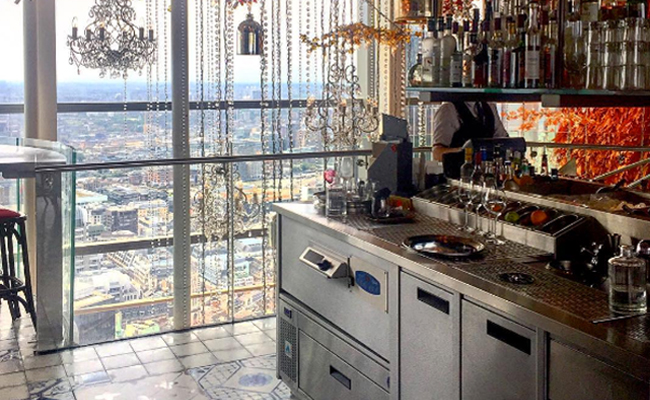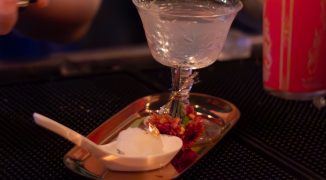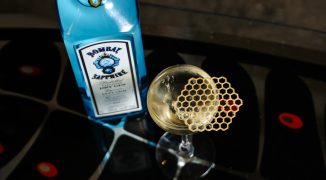From speed and efficiency to ergonomics, the layout and structure of a bar can have a lot of impact on its bartenders. (And, whether it manifests in dropped bottles or strained backs, a poorly designed bar comes with a host of drawbacks in the long run.) With innovations like the speed rack and Francesco Lafranconi’s racetrack well, bar owners and design consultants have worked to surpass some of the common challenges presented by traditional bar design. But what happens when an actual bartender gets to call the shots on giving his team’s workspace an extreme makeover? Well, it looks a little something like this:
https://instagram.com/p/BFoDiP-vyM0/
Richard Woods, the head of spirit and cocktail development at London’s Duck & Waffle, was recently tasked with completely overhauling the bar at the 40th-floor, 24/7 restaurant, a process that took about a year start-to-finish (and no easy feat for a bar that never actually closes). For Richard, it was all about designing a bar “from a bartender’s heart but an operator’s mind.” And, after four years of servicing 800-900 diners a day, Woods says the team had put the bar through its paces. “In 4 short years had reduced a pre-pubescent, cocky, teenage boy to a withering and broken old man,” he says.
So, starting with a wishlist and whittling it down based on both budget and practicality, Woods began the lengthy process of working with a manufacturer to create a bespoke bar that maximized the flow of service and also answered to the very unique challenges that Duck & Waffle faces (such as having their prep area 41 floors below the actual restaurant itself). And while efficiency and ease were the priorities, a few extra bells and whistles — like built-in sous vide baths, a blast freezer and a nitro trolley — made it into the final design, too. We caught up with Richard to see what it’s like when a bartender gets to call the design shots on his dream bar setup:
Tell us about the old bar at Duck & Waffle. What were some of the things you struggled with, layout-wise, and why did you decide to go for an upgrade?
Duck & Waffle’s bar was created as a chef bar. Wanting not just to emulate the creative process but the order of a well run kitchen, the initial idea was to remove the bar counter — which is a divide between the bartender and guest, enabling us to bring them into the experience. Each bartender runs their own station much like a kitchen with each being responsible for a minimum of 50% of the menu, depending on how many stations are open on a specific day. The expo station responsible for calling out the orders and quality control is, of course, the heart of the bar.
With many projects, from the design process onwards, a business doesn’t perform quite as expected. Be it levels of trade, flow of service or deliverance of a product. Unfortunately in some cases this performance is worse; with others, like Duck & Waffle, this was a positive. The old bar needed to be replaced because we had put it through its paces, and in 4 short years had reduced a pre-pubescent, cocky teenage boy to a withering and broken old man. Being a 24/7 operation meant that there was never a time when it wasn’t being used. Cleaning had to be done little and often to ensure everything was immaculate and up to standard, and simple things such as drawers that were being pulled open for every drink needed to be replaced regularly.
https://instagram.com/p/BFvp5dMPyIh/
How long did it take you, from starting the search to having the final installation done?
Around a year. First off, with such an undergoing, we needed to find the time in which to do this. In a 24/7 business, a bar servicing a restaurant that seats 800-900 diners every day and with overnight and weekend brunches being some of our busiest services, we couldn’t simply close. Then came the budget. How do you start by putting a cap of the cost of a bespoke piece? This started as a wish list and was gradually reduced, less actually for cost implications but also for practicality. It’s still not 100% complete, though, as the final element — a nitro-trolley bar that attaches to the main unit — is currently in its manufacturing stage. This sits snugly within the main unit but can be rolled out to deliver a bespoke service to the bar booths, private dining room or diners in the main restaurant.
How custom was it?
Very custom. I have always felt that whilst fabricators or the like build with quality, they need to have a working understanding of each and every one of the businesses that they consult and are building for. So often, I have been shown bar drawings from so-called designers that really have not got the idea or flow of service right. I work the bar in each of the locations I oversee so I designed the 2.0 version from a bartender’s heart but an operator’s mind. That said, I sought counsel from the manufacturers on regular occasions as well as the bar team, as I wanted them to question and comment on the practicality of the project. There were several design meetings as expectations and reality often crossed paths. The end result is a bespoke piece from a couple of companies that collaborated on the build.
https://instagram.com/p/BFyD2NbvyL0/
What were some of the basic, must-have specs that you definitely wanted in your new bar?
Ultimately this process was about speed and efficiency. Sure, the bells and whistles are great, but they aren’t there for noise and attention, but to simplify a process, to better expedite service and make the whole experience more enjoyable. Bringing the prep work space into the bar and integrating it under the cocktail stations was crucial. As you can imagine in a venue with such great views, the FOH space is priceless but means the BOH areas are limited. Our prep area was in our basement (minus level 1 below ground) and Duck & Waffle is on level 40. This caused logistical problems as the bar had to run with military precision to ensure nothing ever ran out.
How about some of the extra bells and whistles?
Sunken Sous-Vide baths under the cocktail stations as well as integrated induction plates enabling each station to transform from kitchen prep to cocktail station. Bespoke fridge/freezer draws that range from +4 to -22 within 20 minutes, as well as a blast freezer. Integrated RO that recycles waste water and ice from cocktails. The last element is that nitro-trolley.
https://instagram.com/p/BF0scrLvyJL/
How will this new bar make your jobs easier and the guest experience better?
Speed has been improved in terms of service time. As bartenders, our hard labour should never translate to a lengthier wait for drinks, and guests should never feel their very basic expectations aren’t being met. Previously special ice, such as blocks and shards, were held in freezers in a back corridor. Now, thanks to the integration of the stations these, as well as frozen or painted glasses and sorbets, are kept in the bar. This has meant less traveling for each bartender and ensured each drink is served promptly.
https://instagram.com/p/BFwDYoYPyJm/
What other practical limitations did you have to keep in mind?
Managing expectations was important: not just the owners’ but also mine. The project started with a wish list and then I managed it from there. The time constraints were important. Ripping out the old bar and part of the floor and installing a brand new unit takes time. We had a little over 50 hours to complete the job and be reset for service. So at midnight one Sunday last month, the old bar was cleaned for the last time and broken down before the engineers came in to dismantle before the new one was built. The team came in from 5 a.m. the following Wednesday to deep clean the new bar before setting up for breakfast service.
Finally: what’s the reaction been from your team?
It has been great. Very positive, but of course, change is always difficult. Despite the old bar needing some love, trying to drop previous habits has been hard. All in all, though, they love their new toy and are excited to get the final piece.rn
https://instagram.com/p/BF6nb0GJQPh/




